When it comes to beauty and resale value, not much comes close to hardwood flooring. The hardwood flooring market currently has an estimated revenue of $64.8 billion and it’s expected to grow in the next few years.
If you’re interested in getting this type of flooring for your own home, there are some important things to know.
Read on to learn whether pre-finished hardwood flooring is the right fit for you and your abode.
Pre-finished vs Unfinished Hardwood
First, let’s look at the differences between unfinished and pre-finished hardwood flooring. Unfinished hardwood is in its raw form, which means that there’s no sheen or coloring added to the material.
If you choose to get unfinished hardwood installed, you’ll also need to choose a finish color to match your home’s aesthetic. Once the finish is added and dried, you’ll also need to apply a sealant to protect the floors.
With pre-finished hardwood floors, the color is already added before the installation begins. This not only saves you time, but it can also save money, too. Most hardwood that comes pre-finished can be installed in one session.
Since pre-finished hardwood uses factory-applied finishes, the look is evenly distributed onto the surface. If you’re looking for something flawless and smooth, this option is probably the better choice. It also takes the guesswork out of making sure you’ve selected the perfect finish before application.
Is Pre-Finished Hardwood Flooring Better?
While it’s ultimately up to you whether choosing pref-finished hardwood flooring is the best choice, there are several pros to picking this option. First, you won’t have to worry about dry times in-between coats. That means you can enjoy your brand-new floors the same day they’re installed.
Because this type of flooring is already finished, you also won’t need to worry about weird odors coming from VOCs. Unfinished hardwood floors need several coats of finish. Applying several coats means your home will likely smell like chemicals for a while until everything is fully dried.
Installing pre-finished hardwood flooring also ensures that your new floors have a nice, thick coat covering every plank. Even if you hire a professional, there’s no guarantee that your unfinished hardwood floors will have an even, perfect application.
Sanding raw or unfinished hardwood is part of the installation process. All of that sand and sawdust is a nuisance and can cause a mess inside your home. With pre-finished hardwood flooring, no sanding is needed so the dust isn’t an issue.
Pre-Finished Hardwood Flooring Problems
There are some drawbacks or cons to choosing pre-finished hardwood floors. First, if a section gets damaged, you’ll have to replace the entire board. It’s almost impossible to match a factory finish to the exact same shade.
With unfinished hardwood, you can usually sand and refinish the damaged areas DIY. As for pre-finished wood, you can’t repair it to make it match the rest of the flooring in the room. This makes it much more expensive to fix if a section is badly damaged.
Since pre-finished hardwood is more difficult to fix, it should also be treated with TLC. Not only should flooring installers be extra careful around it, but so should everyone in the household.
It may not be a good idea to install this flooring in areas with a lot of heavy foot traffic. If you do, make sure you cover the “busiest” areas of the floors with some protection like floor mats or area rugs.
Most pre-finished hardwood flooring also has open seams. Unlike finished wood, there’s no material applied (like finish and sealant) to fill in the small “gaps” between boards. Even if the installers do a great job of keeping the flooring tight, there’s still a risk of moisture infiltrating the cracks and crevices.
Although there’s a heavy coating applied to pre-finished hardwood, it’s much more difficult to refinish. Too much sanding will wear down the wood, making it unusable.
There’s a difference in the prefinished flooring price compared to the unfinished version, too. Add around $1 to $3 per square foot to pre-finished floors. This brings the cost to around $5 to $23 per square foot compared to $4 to $20 per square foot for unfinished hardwood.
Cleaning and Maintenance
It’s important to know how to clean hardwood flooring to keep it looking its best. If you have pre-finished hardwood floors, try o dust and sweep them regularly. Use a soft, microfiber cloth or a soft-bristle broom so you don’t damage the topcoat.
Avoid using any wet mops or steam cleaners to clean your pref-finished wood floors. This will expose the boards to moisture, which could cause damage or buckling over time.
Never use harsh, abrasive cleaning products on pre-finished hardwood floors. These products can scratch the coating and the protective surface, and will eventually cause stains to permeate underneath. Only use cleaning products that are specifically formulated for pre-finished hardwood.
To clean the floors, spray the cleaning solution directly onto the mop or the cloth first. Then, gently wipe it across the surface of the floors in the direction of the planks.
Try to minimize direct sunlight exposure, as UV rays can cause your flooring to fade. With regular care and the right maintenance, they should look beautiful for many years to come.
Pick the Perfect Flooring
Now that you know more about pre-finished hardwood flooring, you can decide whether they’re the right option for you. With a bit of research and good maintenance, these floors should last a lifetime.
For more great articles about home, tech, lifestyle, and more, check out the rest of our website today!









